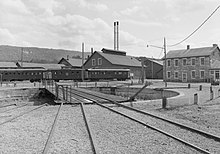1874 United States Supreme Court case
| Sioux City & Pacific R.R. Co. v. Stout | |
|---|---|
 Supreme Court of the United States Supreme Court of the United States | |
| Decided January 26, 1874 | |
| Full case name | Sioux City & Pacific R.R. Co. v. Stout |
| Citations | 84 U.S. 657 (more)17 Wall. 657; 21 L. Ed. 745 |
| Court membership | |
| |
| Case opinion | |
| Majority | Hunt, joined by unanimous |
Sioux City & Pacific Railroad Co. v. Stout, 84 U.S. (17 Wall.) 657 (1873), was a case decided by the Supreme Court of the United States that first enunciated the idea that a landowner could be liable for the injuries of a child trespasser.
Background

On March 29, 1869, a small child was injured by a railroad turntable owned by Sioux City and Pacific Railroad, which was being operated in Blair, Nebraska. The child was playing on the turntable, which injured his/her foot. The father took the company to court in the federal Circuit Court for the District of Nebraska. After a first jury trial failed to reach a decision, a second jury awarded the father $7,500 in 1872. The railroad then sought a writ of error from the Supreme Court.
Decision
A child was injured by a railroad turntable owned by Sioux City and Pacific Railroad, which was being operated in Blair, Nebraska. Sioux City & Pacific Railroad company was held liable, despite the prevailing idea that a landowner was not held liable for injuries to trespassers. Trespassing children were thought to be a special case that required a higher duty of care. This theory of liability came to be known as the "turntable doctrine" and later the attractive nuisance doctrine by the case Keffe v. Milwaukee & St. Paul R.R. Co.
See also
- Chicago B. & Q.R. Co. v. Krayenbuhl: A similar case
- List of United States Supreme Court cases, volume 84
- Blair, Nebraska
External links
- Text of Sioux City & Pacific R.R. Co. v. Stout, 84 U.S. (17 Wall.) 657 (1873) is available from: Cornell Justia Library of Congress OpenJurist
References
- Hudson, Manley O. (May 1923). "The Turntable Cases in the Federal Courts". Harvard Law Review. 36 (7): 829–830. doi:10.2307/1328445. JSTOR 1328445.
- 84 U.S. at 659.
- 1873 in United States case law
- 1873 in case law
- 1873 in rail transport
- Chicago and North Western Railway
- Child safety
- United States railway case law
- Railway turntables
- United States circuit court cases
- United States negligence case law
- United States Supreme Court cases
- United States Supreme Court cases of the Chase Court